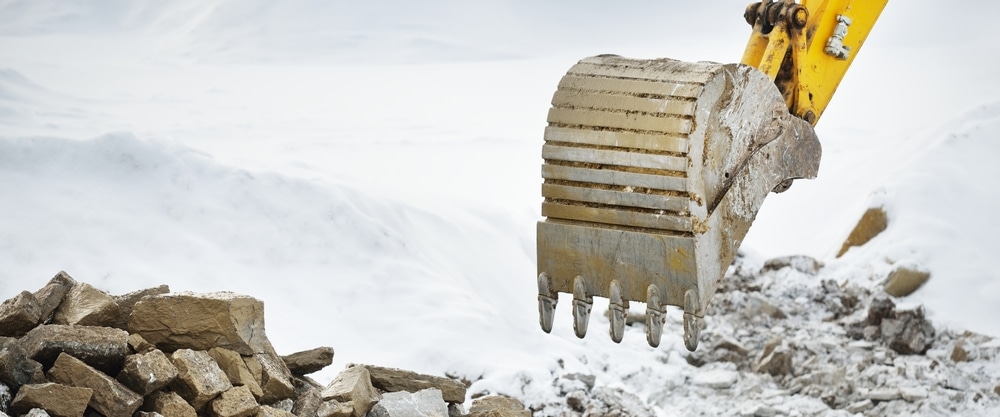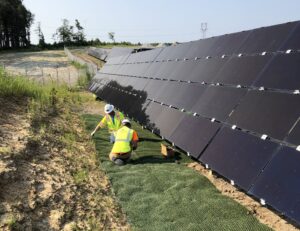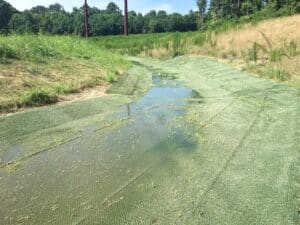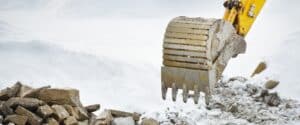Are you prepared for what El Niño will bring this year for construction? Depending on where your projects are located, you could see a longer, more productive winter, or you could see a host of weather-related setbacks. Warm, dry weather facilitates easy work that wraps up ahead of schedule, while inclement weather can throw off entire timelines, necessitate costly re-dos or repairs, or even lead to worker injury. All the while, erosion is waiting in the wings to pounce on any unprotected or otherwise vulnerable soil.
As the producers of InstaTurf ShearForce erosion control products, we spend much of our time thinking about erosion. Weather has a massive effect on erosion, and erosion has a massive effect on construction budgets, timelines, and longevity. The Climate Prediction Center—a division of the National Weather Service—recently released their predictions for this winter’s climate in the U.S. and it’s something of a mixed bag when it comes to possible effects on construction. We’ll break down their predictions in detail and discuss what the implications are in the U.S. construction and earthmoving industries.
Temperatures: Warmer Weather in the Northern U.S.

Image Credit: NOAA
Let’s start with some good news for the industry: A large portion of the Northern U.S. is projected to see temperatures above normal due to the El Niño weather pattern. New England and the Pacific Northwest are projected to be the most likely regions to see higher than normal temperatures. Both the West coast and the Northern half of the East coast are likely to see above normal temperatures as well. Warmer temperatures could delay ground freezing and result in more rain instead of snow, which would increase erosion potential in these areas.
The Southern U.S. is largely predicted to have an equal chance of seeing above normal and below normal temperatures with one exception: the Climate Prediction Center expects temperatures to be near normal in a radius centered on the Northernmost tip of Texas, extending to the borders of neighboring states (including New Mexico, Colorado, Kansas, Oklahoma, and, of course, Northern Texas).
There is a subtle difference between projected “near normal” temperatures and projected “equal chances” of above and below normal temperatures. Put simply, if you have any projects around that area centered in Northern Texas, past climate data will be a good indicator of how the winter will look, and you can prepare accordingly with some sense of certainty. An “equal chances” prediction is less certain, and the area is at an increased likelihood of seeing abnormal temperature swings.
Alaska and Hawaii are projected to have largely above normal temperatures.
The projected warmth in the Northern continental U.S is a big deal for construction projects because the regions where temperature typically drops more significantly in the winter are projected to stay warmer longer, and the usually warmer regions in the South will likely stay warm as well. It’s also somewhat reassuring that no area is predicted to see lower temperatures than normal. In short, this all means more opportunity to get work done before soil temperatures drop below freezing and working conditions worsen.
As for erosion, things seem positive for the warmer Northern U.S. On one hand, it has been observed that higher water temperatures lead to an increased rate of erosion, but this relationship has been found to likely be a result of the difference in temperature between the flowing water and the soil beneath. There seems to be a positive relationship between soil absorbing thermal energy and rate of erosion. Put simply, when both soil and water temperatures are equal, temperature changes don’t seem to have an appreciable effect on erosion rates. Since we’re likely to see warmer temperatures in the North, we predict that less thermal energy is likely to be transferred to the soil from flowing water due to the soil being at a raised ambient temperature. Therefore, we predict less erosion than normal in the North, except in areas affected by abnormally wet conditions or drought.
As for erosion in the South, we don’t have any reason to expect a marked difference in erosion rate from the norm based on temperature alone—but that’s not the end of the story. We’ll discuss some additional factors that determine erosion rates below…
Precipitation: Wetter Weather in the Southern U.S.
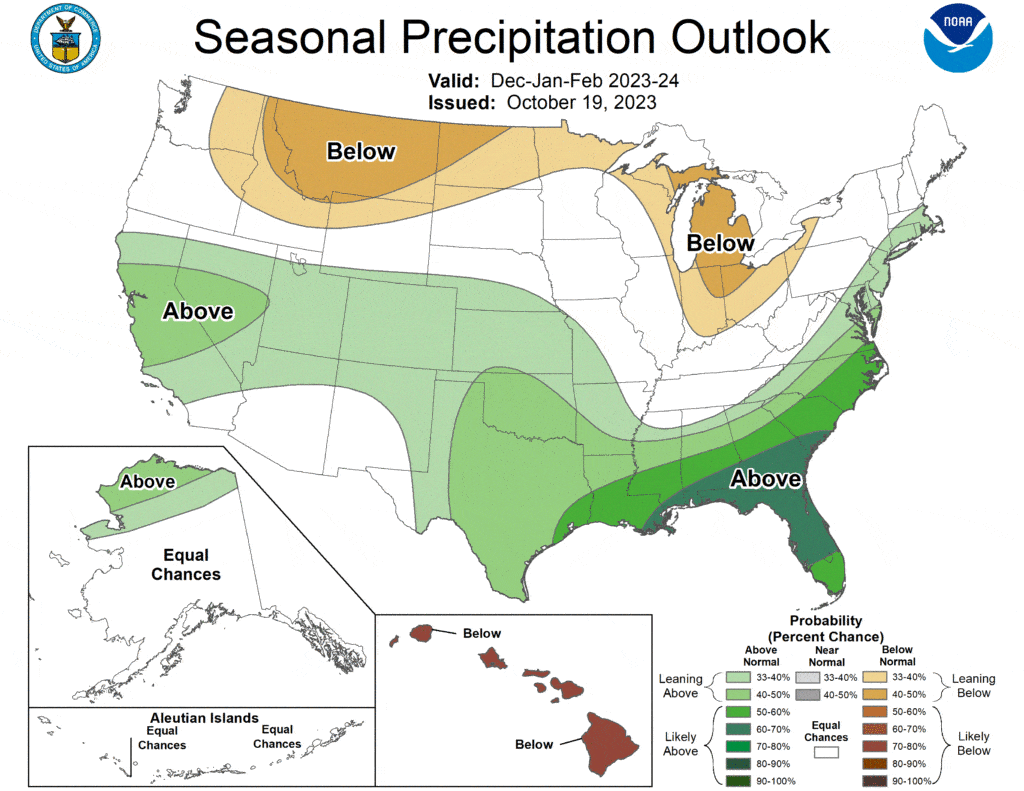
Image Credit: NOAA
We started with the good news, but luckily the “bad” news isn’t too dire. Most of California as well as the Southern half of the U.S. is projected to have an above normal probability for precipitation—largely as a result of El Niño as well. Though the total area predicted to see above normal precipitation is quite large, only Northern California and most of the Southeast have a significant (50%+) chance of above normal precipitation. Conversely, Montana and the surrounding area as well as Michigan and its surrounding area are projected to see below normal precipitation.
If any of your projects are in either of those alliterative ‘M’ states, you’ll likely see fewer storm events and less ground saturation. On the other side of that coin, if you have projects in the Southeastern U.S. or Northern California, it might be prudent to plan for increased ground saturation, more storm events, increased soil loss from erosion, and subsequent project delays.
Hawaii comes with its own unique challenges for construction. As you may expect from this year’s wildfires, Hawaii is projected to be a bit of an outlier in terms of precipitation as it is predicted to be much drier than normal, more than any other region in the U.S. (as compared to that area’s average).
Increased precipitation generally means an increase in rate of erosion. The Southern U.S. is likely to see an increase in erosion rates over the coming months, so preemptive installation of erosion control products is advised.
What Effect Will Drought Have on Construction?
One parameter we’ve omitted up to this point is the Climate Prediction Center’s outlook on drought.
The drought predictions generally align with the Climate Prediction Center’s temperature and precipitation predictions, as one would expect. For example, the inland Pacific Northwest is likely to see increased temperatures and decreased precipitation. We know those two trends lead to drought, and the rain shadow area of inland Washington happens to be the only area in the continental U.S. where new drought is likely to develop, not to mention the existing drought in the surrounding area. In the future, this could mean increased rates of erosion as land which has experienced drought will have drier topsoil and less vegetation to bind the soil, so it’s at an increased risk of soil loss when precipitation does occur. Hawaii is in the same boat, and the fires have only exposed more vulnerable soil to wind and water.
We advise that you monitor weather conditions in these drought areas if there is any likelihood that you will have a project nearby. Alarm bells should go off in your head if you see an increased rate of precipitation in drought areas. If you have a project in those areas now, you’ll want to preempt precipitation with reliable erosion control products.
Speaking of increased precipitation on lands experiencing drought, the Gulf Coast is in a drought—though it is improving—and it’s likely to see increased precipitation this winter according to the Climate Prediction Center. Again, land that has experienced drought is at a greater risk of soil loss once it does see precipitation. If you have projects in and around the Gulf Coast, you are now in a bit of a time crunch to prepare for increased erosion during winter construction as well as after completion. Erosion can happen quickly, and you don’t want to be caught flat-footed when erosion has already begun to damage your site or structures therein.
Looking Ahead…
To summarize:
- Warmer, drier Northern U.S. leading to less erosion in the short-term
- No areas predicted to be below normal temperature, meaning relatively good working conditions
- Likely stable, normal temperatures in area centered in Northern Texas and extending as far as Northern Colorado
- Increased Precipitation in Southern U.S., particularly in and around Florida, increased rates of erosion as a result
- Increased risk of erosion in drought areas around Gulf Coast due to increased precipitation on dry soil
- Drought likely to develop in Eastern Washington, possibly leading to more soil loss in that area down the road when precipitation normalizes
In all, it appears to be a largely positive weather outlook for the construction and earthmoving industries this winter. There are just a few areas where complications from precipitation and subsequent erosion are more likely.
If you want to protect your site from whatever mother nature throws at it, InstaTurf ShearForce products are lightweight and easy to install but immediately protect soil as well as rock riprap. InstaTurf supports real vegetation growth so your site can naturally protect itself for the foreseeable future. Whether your site sees little rain or an absolute deluge, InstaTurf protects soil and can be installed without heavy machinery at any point in the year.
See how InstaTurf handled immediate precipitation from Hurricane Isaias just after installation.

